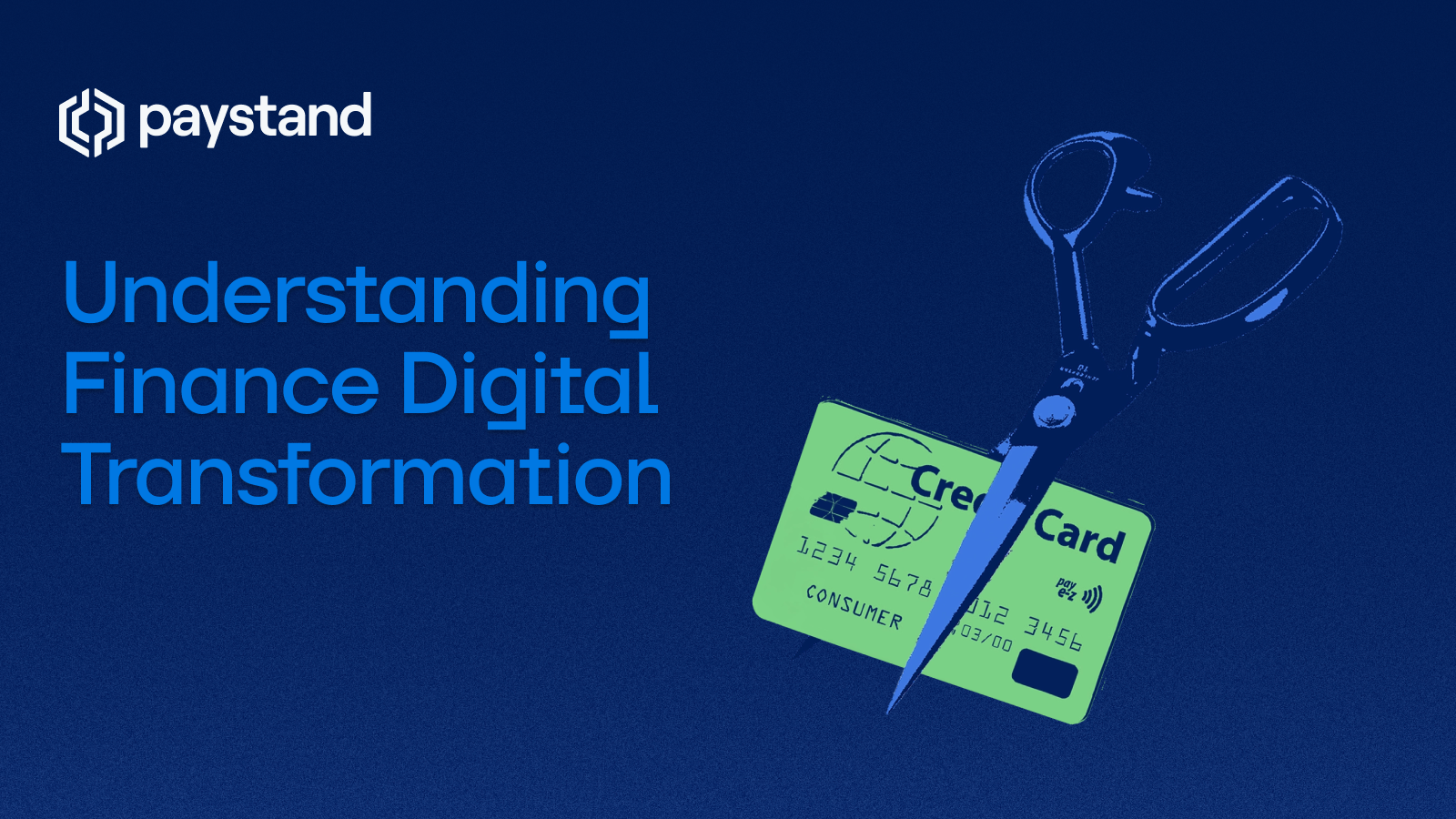Understanding Finance Digital Transformation

Table of contents:
- What is Digital Transformation in Finance?
- Key Technologies Driving Financial Digital Transformation
- 3 Benefits of Digital Transformation in Finance
- Challenges Finance Leaders Face in Digital Transformation
- Best Practices for a Successful Digital Finance Strategy
- Transform Your Cash Flow Process
Key takeaways:
- A finance digital transformation involves modernizing a finance team’s tech stack for efficiency and cost-effectiveness.
- There are many benefits to digital finance, including increased transparency, improved financial management, and faster month-end close.
- Finance leaders can apply best practices to implementing digital tools to overcome common challenges in the process.
Finance digital transformation leverages technology to streamline processes, improve data accuracy, and enhance decision-making. It automates processes, uses advanced analytics tools, and integrates technologies like blockchain and decentralized finance (DeFi) into financial operations.
By embracing digital transformation, finance teams can:
- Streamline routine tasks
- Reduce errors
- Save time for strategic analysis and decision-making
Finance automation is pivotal in this transformation. It enables faster and more accurate tasks like data entry, reconciliation, and financial reporting.
What is Digital Transformation in Finance?
Digital transformation in finance usually refers either to a technology shift away from legacy software to innovations for either financial institutions or financial teams, such as a company’s accounting department. From accounts receivable (AR) automation to streamlined travel and expense (T&E) reporting, most functions of corporate finance can be improved with new tech.
Finance leaders have increasingly invested in digital finance since the pandemic, with 75% of CFOs stating that digital transformation was a top priority in 2024. And it’s clear why this matters when we look at specific finance functions.
Take invoice processing, for example. According to Ardent Partners’ AP Metrics That Matter in 2025, the average invoice processing time is just over nine days per invoice. This drops to 3.1 days for companies using best-in-class software. And the cost? Instead of paying up to $12.88 per invoice, companies with top-notch AP software are paying only $2.78.
The Profit Paradigm Podcast
We're flipping the script on finance. No fees. No friction. Just pure cash-flow power. If you're ready to automate, accelerate, and take control of your revenue, this is where the future of money movement begins.
Key Technologies Driving Financial Digital Transformation
Technological advancements make digital transformation possible in the finance sector. These digital technologies—ranging from AI to blockchain—are the foundation of modern finance operations and innovation. Innovations in communication speed and, more importantly, security, enable financial teams to leave legacy software behind. As a result, finance and accounting professionals enjoy more flexibility while taking on a more strategic role.
There are four technologies that take center stage when discussing finance:
- Artificial Intelligence (AI) and machine learning (ML) make it possible for finance teams to rapidly process documentation and nearly eliminate manual data entry. A significant leap from Robotic Process Automation (RPA), AI can review invoices, POs, and other unstructured data and record relevant information. It can also match documentation, identify duplications or vulnerabilities, and discover areas for savings—it all depends on how it’s used.
- Cloud software enables teams to work remotely, collaborate more easily, and manage leaner information storage. As a result, it’s simple to handle tasks in real-time and access key information from anywhere.
- Blockchain technology offers another level of security for finance teams. When working with sensitive data, it’s critical to have a secure way to store and transmit information. A hybrid blockchain, as seen in platforms like Paystand, can also not be changed, thus improving security.
- Big data analytics allow teams to crunch big numbers quickly and gain better insight into financial data. In other words, access to more data has offered finance teams with more accurate information, improving their capacity for decision-making.
3 Benefits of Digital Transformation in Finance
Upgrading your tech stack isn’t just an item on your checklist. When executed strategically, integrated digital tools transform the finance function. An eight-year study from China found that digital finance can improve cash flow, expand financing options, and further promote the idea of digital transformation across departments. To get a better idea of how a digital transformation strategy can impact your accounting and financial management, let’s take a look at three key benefits.
Increasing Transparency with Decentralized Finance (DeFi)
Blockchain offers immense potential for enhancing transparency, security, and efficiency in financial transactions. Its decentralized nature eliminates the need for intermediaries, reducing costs and the risk of fraud. Businesses can explore blockchain-based solutions for payments, smart contracts, and supply chain finance.
The emergence of decentralized finance (DeFi) presents new opportunities for accessing capital, managing investments, and executing financial transactions without intermediaries. By leveraging DeFi protocols, finance professionals can unlock liquidity, optimize asset use, and explore innovative financial instruments.
Enhancing Business Financial Management
Effective business financial management drives growth, mitigates risks, and maximizes shareholder value. Digital transformation gives finance teams real-time insights into financial performance, identifies trends, and forecasts future outcomes. Finance workflow automation shaves hours, if not days, off of processing times. And advanced analytics tools empower data-driven decisions to allocate resources strategically.
Finance digital transformation facilitates collaboration between departments, breaking down silos and fostering cross-functional alignment. Businesses can optimize resource allocation and improve cost efficiency by integrating financial data with operational metrics.
Optimizing Month-End Close with Digital Transformation
The month-end close process is a critical aspect of financial operations. Manual effort, lengthy delays, and an increased risk of errors often characterize it. Digital transformation streamlines and optimizes this process, reducing time and enhancing accuracy.
Automating routine tasks helps finance teams speed up the month-end close, minimizing the risk of errors and discrepancies. Leveraging financial reporting tools enables businesses to generate comprehensive reports, providing timely insights into financial performance.
Finance digital transformation holds immense potential for businesses to enhance efficiency and decision-making. By embracing finance automation, leveraging technologies like blockchain and DeFi, and optimizing business financial management practices, organizations can unlock new opportunities for growth and innovation in the digital age.
Challenges Finance Leaders Face in Digital Transformation
It can seem easy to swap out one software for another—but nothing could be further from the truth. Finance leaders managing company finances across industries face several challenges related to digital transformation strategy and implementation. While 31% of CFOs note that financial constraints are a primary barrier, it isn’t the only one. Issues range from selecting the best software to more nuanced implementation strategies and team-related conflicts.
For example, many finance leaders must first make their case for spending resources on updating the finance tech stack. To bring other stakeholders on board, it’s critical to highlight not only cost savings but also how these changes match overall business goals. You must also make a case to the finance team to ensure quick adoption. Rather than using objective-focused arguments, it can be more helpful to make it clear that the team will be included in the decision-making process.
In addition, finance leaders will need to review how the new software will integrate with legacy solutions, risk management workflows, and compliance processes. Selecting software with robust security features can offset some of this strain. Even so, focusing on these processes cannot be ignored.
Finally, finance leaders will also need to organize a training program and edit company policy to match the new programs and processes.
Best Practices for a Successful Digital Finance Strategy
Drafting and implementing a successful digital finance strategy doesn’t just happen. Follow these best practices and you’ll find it much easier to navigate the process:
- Map your entire finance process and identify bottlenecks, confusing workflows, and similar issues.
- Prioritize areas to digitize or automate, and focus on one process at a time.
- Select your new tool, keeping budget, scalability, security, and customer support in mind.
- Get the entire finance team involved in choosing your solution.
- Define goals to implement and evaluate your new software.
- Work together with your new solution to provide training and revise your company policy, if necessary.
- Track software performance and staff perspectives on the software.
- Optimize and move on to digitizing the next finance process.

Transform Your Cash Flow Process
Digital transformation in finance, when implemented correctly, makes key finance functions feel effortless. Tools like automation and AI, in particular, not only reduce errors but also save time for the finance team. As a result, the role of finance shifts within the organization. Instead of spending endless hours on data entry, the finance team strengthens strategy and moves the organization forward.
But before you can reach this point, it’s important to select the technologies that make the most sense for your business. For many, it’s AI.
Discover practical AI strategies that improve reporting accuracy by as much as 30% in our recent whitepaper, How Finance Leaders Are Using AI Today.





